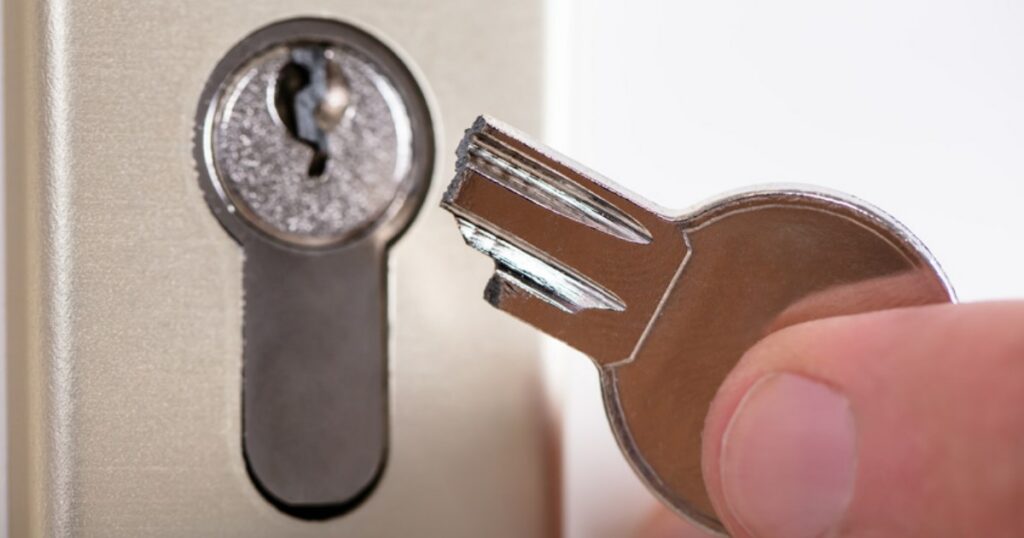Introduction
A key stuck in a lock is a common and frustrating problem that many people encounter, and it’s essential to resolve the problem of a key stuck in a lock quickly to avoid greater and costly inconvenience. By acting quickly, you prevent further potential damage to the key, lock or door, reduce the inconvenience of unavailable entry, improve the security of your property and save time and money on repairs.
Understanding the situation
A key can get stuck in a lock for a variety of reasons. This can be due to a bent or worn key that is struggling to fit or turn properly in the lock. In addition, the lock itself may be damaged, causing excessive friction or jamming when the key is inserted. In some cases, dirt, dust or rust can build up inside the lock, creating an obstruction for the key. Understanding the underlying cause of the stuck key is essential to choosing the appropriate method for removing it and preventing it happening again in the future.
Forcing the key when it is stuck in the lock can make the situation worse. It can cause the key to break inside the lock, making the problem even more difficult to solve. It can also damage the lock itself, requiring costly repairs. Rather than force the issue, it’s best to use appropriate methods to gently remove the stuck key, reducing the risk of further damage and costs.
Tools needed
Fine-nose pliers: To gently grip the key and extract it from the lock. Lock lubricant: To reduce friction and facilitate the movement of the key in the lock. Fine metal file: Useful for smoothing the rough edges of the key and making it easier to insert. Flat-head screwdriver: Can help remove components from the lock if necessary to gain access to the stuck key.
Tweezers: For manipulating small parts or adjusting internal lock components. Spare key: If available, another key can sometimes be used to help free a stuck key. Lock release kit: Includes special tools designed to extract stuck keys or pieces of broken key.
Step by step
For cylinder locks (European cylinder):
Step 1: Assess the situation – Examine the key and lock to determine if the key is bent, worn or damaged. Identify the underlying problem.
Step 2: Lubricate the lock – Apply lock lubricant to the lock and key. Gently insert the key and try to turn it. Sometimes lubrication is enough to free the key.
Step 3: Use fine-nosed pliers – If lubrication doesn’t work, use fine-nosed pliers to grip the stuck key. Gently twist while pulling towards you to extract the key.
Step 4: Repair or replace – If the key is broken inside the lock, consider calling a professional locksmith to repair or replace the lock if necessary.
For deadbolts:
Step 1: Assess the key – Examine the key for visible damage. If the key appears bent, carefully straighten it.
Step 2: Lubricate the lock – Apply lubricant to the keyhole. Insert the key and turn it gently to distribute the lubricant inside the lock.
Step 3: Use a flathead screwdriver – Insert a flathead screwdriver into the slot in the lock and turn gently to try to free the key.
Step 4: Be patient – Be patient and gentle. Don’t force the key. If the key won’t budge, consider calling in a professional locksmith.
Step 5: Dismantle if necessary – If the key is broken off inside the lock, it may be necessary to dismantle the lock to gain access to the stuck key. This is usually best done by a professional.
General tips
Regular lock maintenance: Apply a lock lubricant at least once a year to keep the internal mechanisms in good working order. This reduces the risk of excessive friction.
Use keys in good condition: Avoid using bent, worn or damaged keys. If your key shows signs of wear, replace it.
Avoid excessive force: Never force a key into a lock if it doesn’t turn easily. This can bend or break the key.
Clean the locks regularly: Remove dirt, dust and rust from the locks with a soft bristle brush and a suitable cleaner. Then dry them thoroughly.
Keep keys clean: Make sure your keys are clean and free of debris before inserting them into the lock. Dirt on the key can be transferred to the inside of the lock.
Avoid excessive moisture: If possible, protect locks from excessive moisture, as rust can cause operating problems.
Get faulty locks repaired quickly: If you notice that your lock is malfunctioning, have it repaired or replaced by a professional before it becomes a major problem.
Be careful when inserting keys: always insert them gently and turn them carefully. Avoid sudden movements.
When to call in a professional
- Key broken inside the lock: If a key is broken inside the lock, it’s advisable to call in a locksmith to prevent further damage to the lock.
- Damaged lock : If the lock itself is damaged or shows serious signs of malfunction, a qualified locksmith can carry out the necessary repairs or replace it.
- Electronic or complex locks: For electronic or highly complex locks, it’s best to call in an experienced locksmith who understands advanced security systems.
- Key loss: If you’ve lost your keys and fear unauthorised access, a locksmith can replace the lock or reprogram electronic locks for your safety.
- Car lock: If you have problems with a car lock, such as a broken key in the ignition or a lost key, a car locksmith can solve these problems in a specialised way.
- Residential or commercial security locks: Security locks often require the expertise of a professional locksmith to ensure they work properly and resist intrusion.
- Emergency situations: In the event of an emergency situation, such as a slammed door with keys inside, a locksmith can intervene quickly to unlock access without damaging the door or lock.
Prevention
To prevent your key from getting stuck in the future, adopt simple preventive practices.
- Apply a lock lubricant regularly to reduce friction and keep the lock mechanism in good working order.
- Make sure you use keys that are in good condition, replacing any that are bent or worn.
- Always insert the key gently and avoid forcing it.
- Make sure the lock is free of dirt, dust and rust by regularly cleaning the inside.
By following these tips, you can extend the life of your locks and avoid the inconvenience of stuck keys.
Conclusion
In this article, we have discussed how to effectively solve the problem of a key stuck in a lock. It is essential to understand the underlying causes, use the appropriate tools and follow specific steps depending on the type of lock. In addition, we’ve stressed the importance of avoiding forcing the key, as this can make the situation worse and lead to higher repair costs. To prevent this problem in the future, regular lock maintenance, the use of keys in good condition and careful handling are essential. Don’t forget that if you find yourself at a dead end, it’s a good idea to call in a professional locksmith to avoid any further damage. Pay attention, follow this advice and don’t hesitate to ask for help if you need it to solve this annoying problem quickly.

